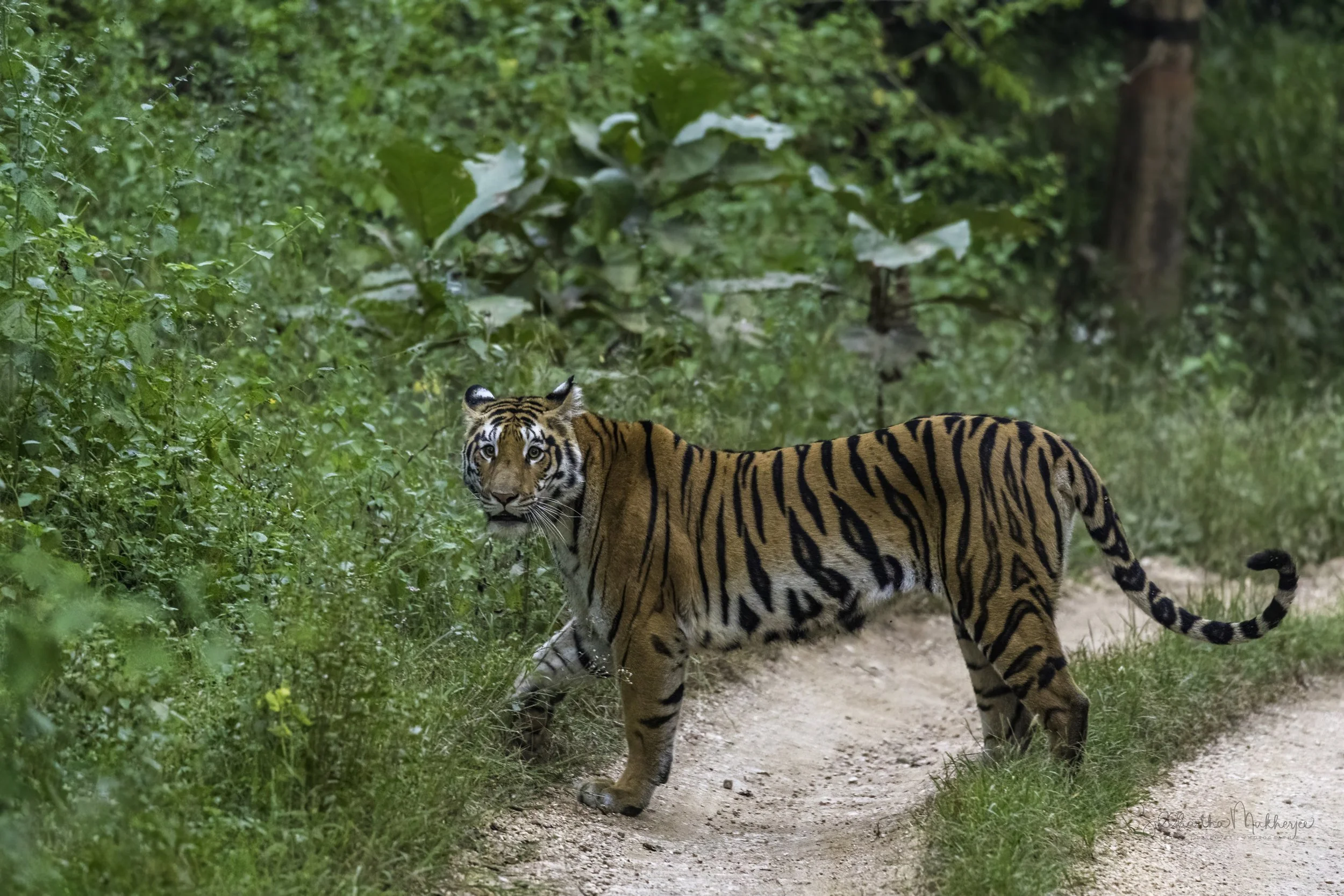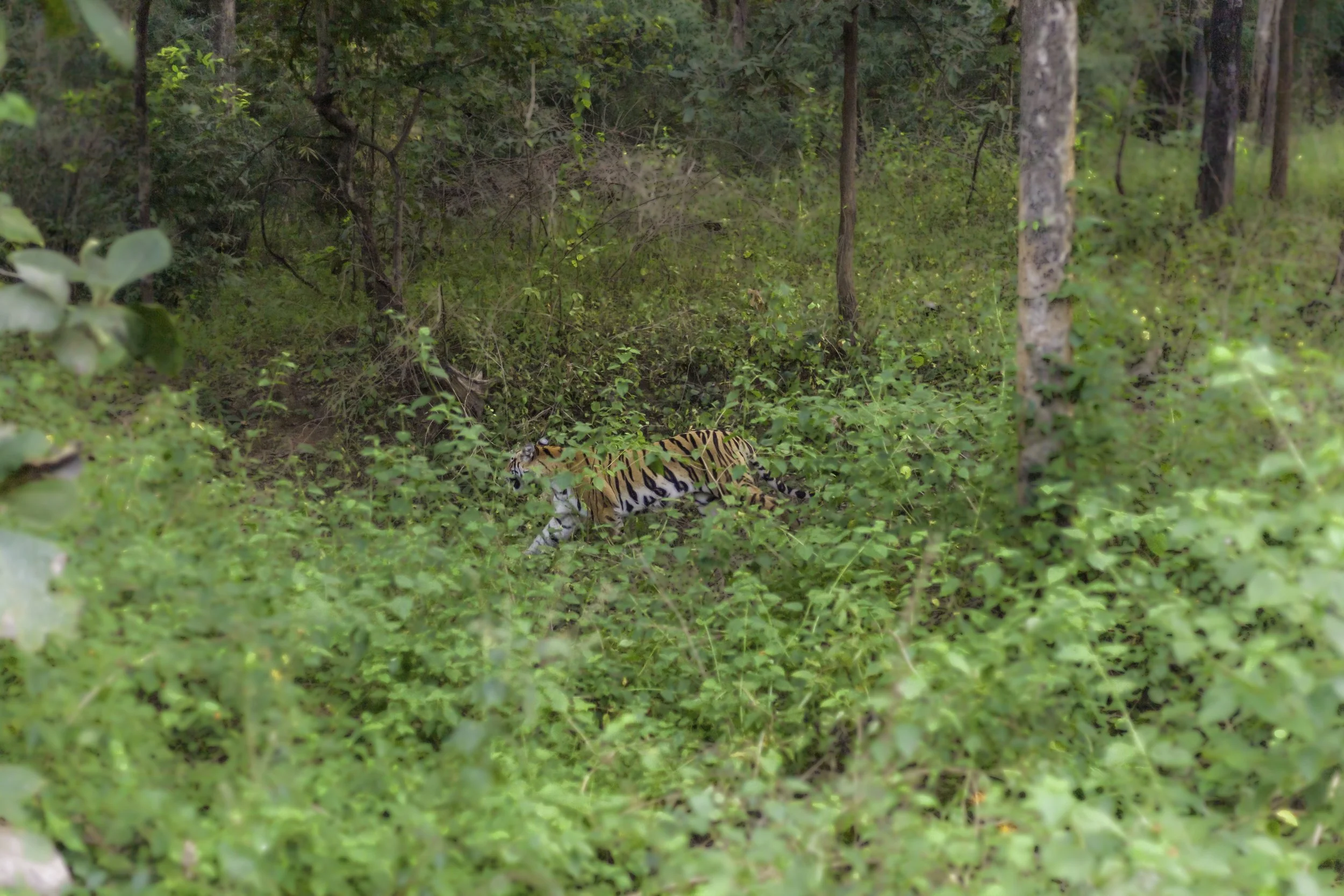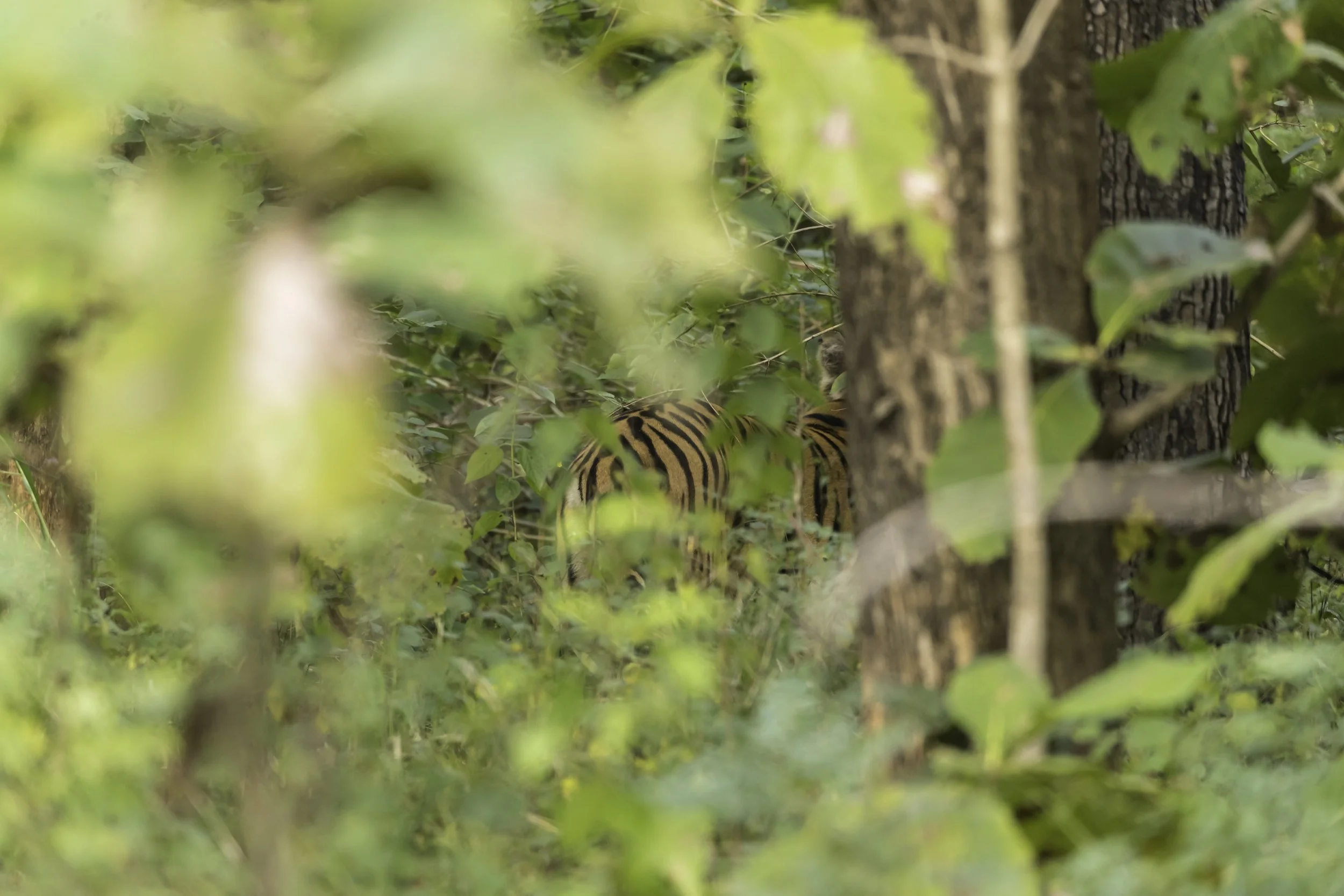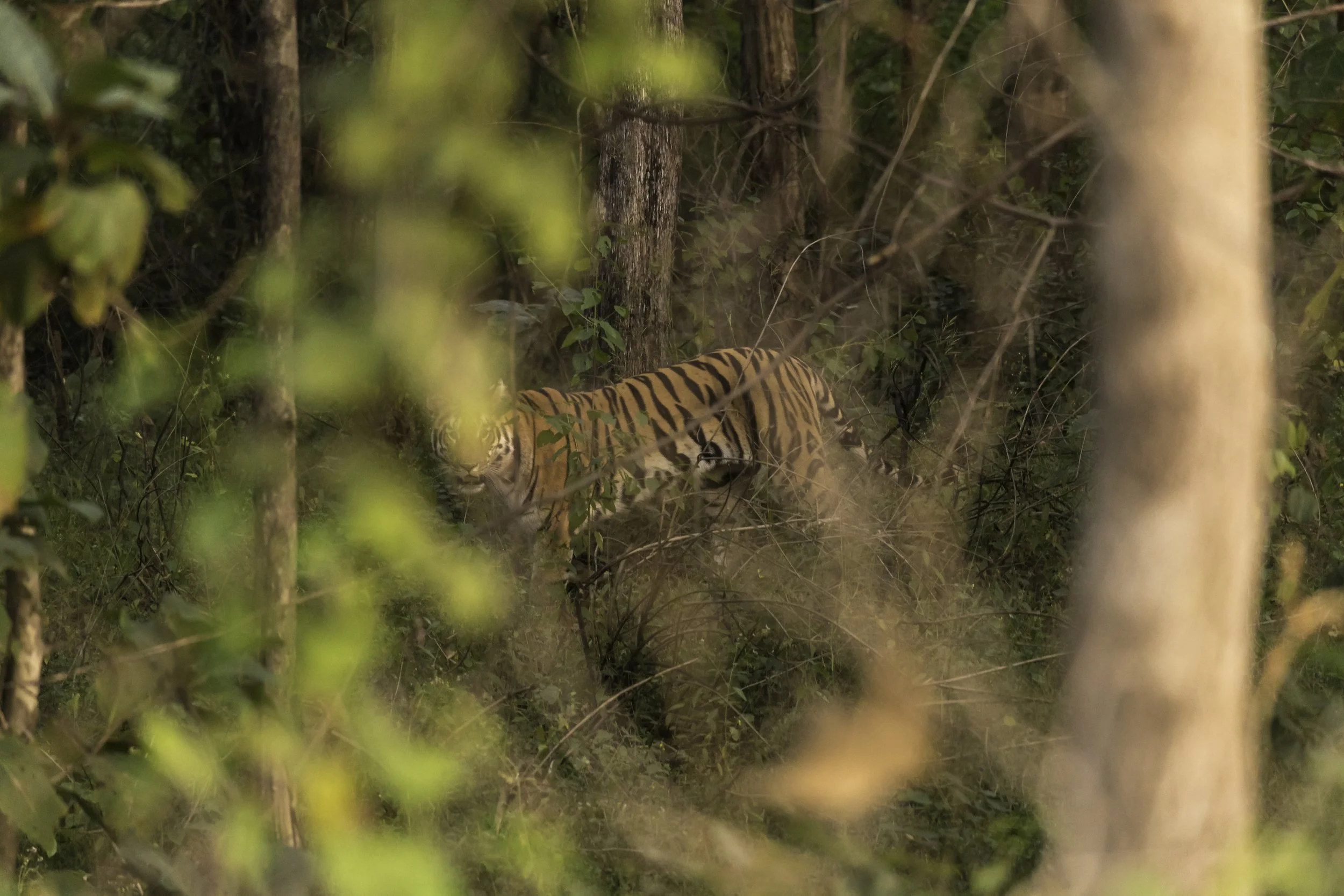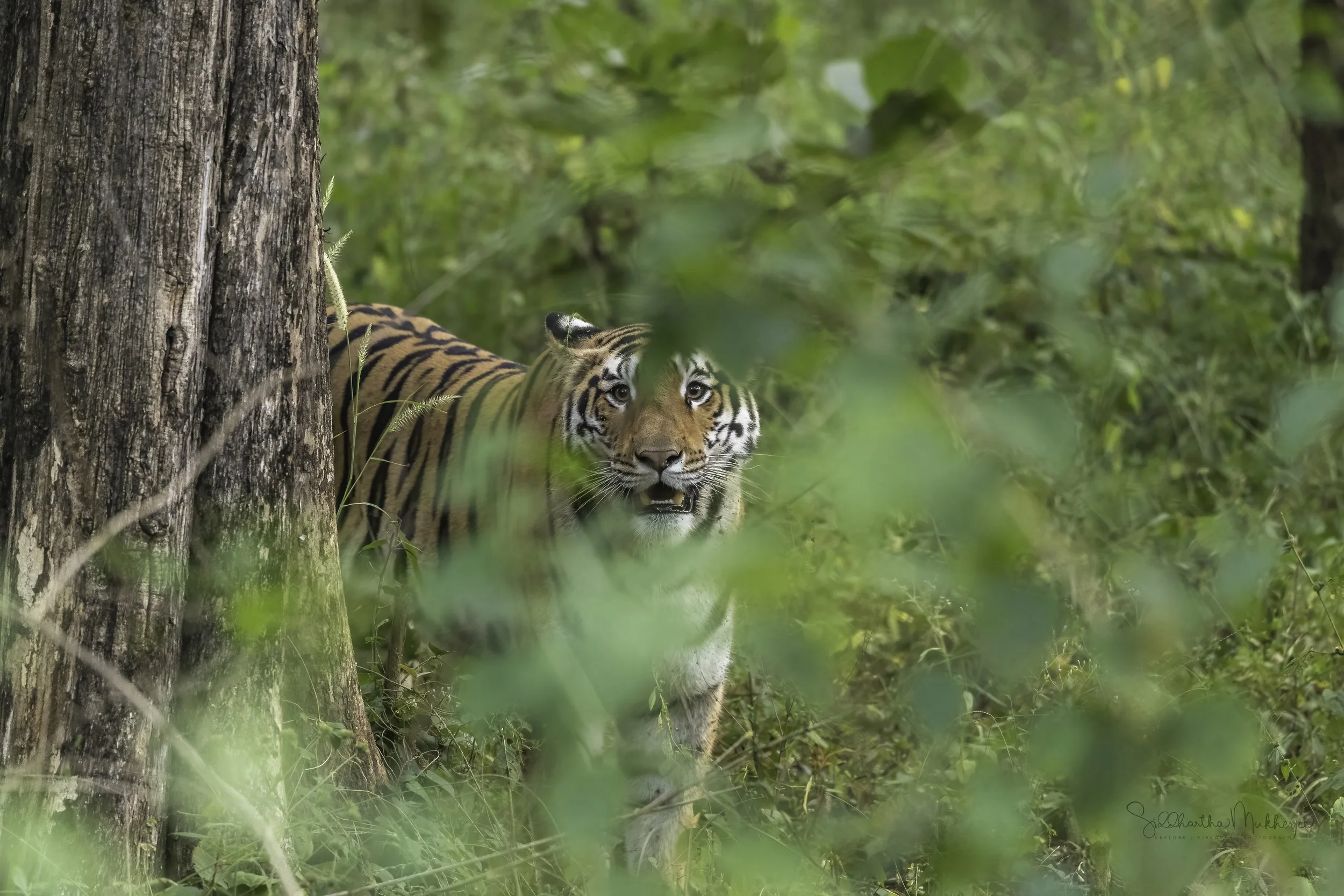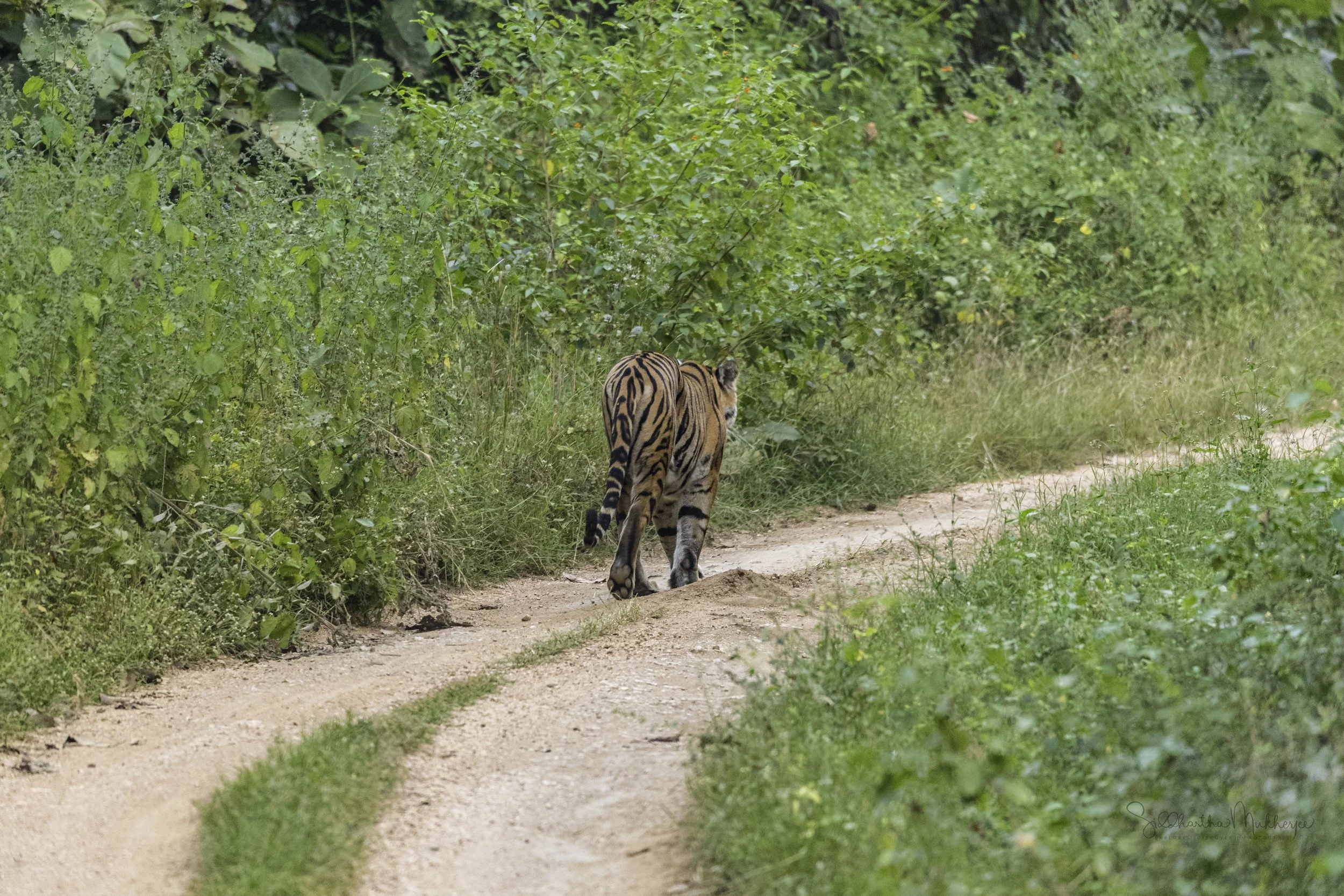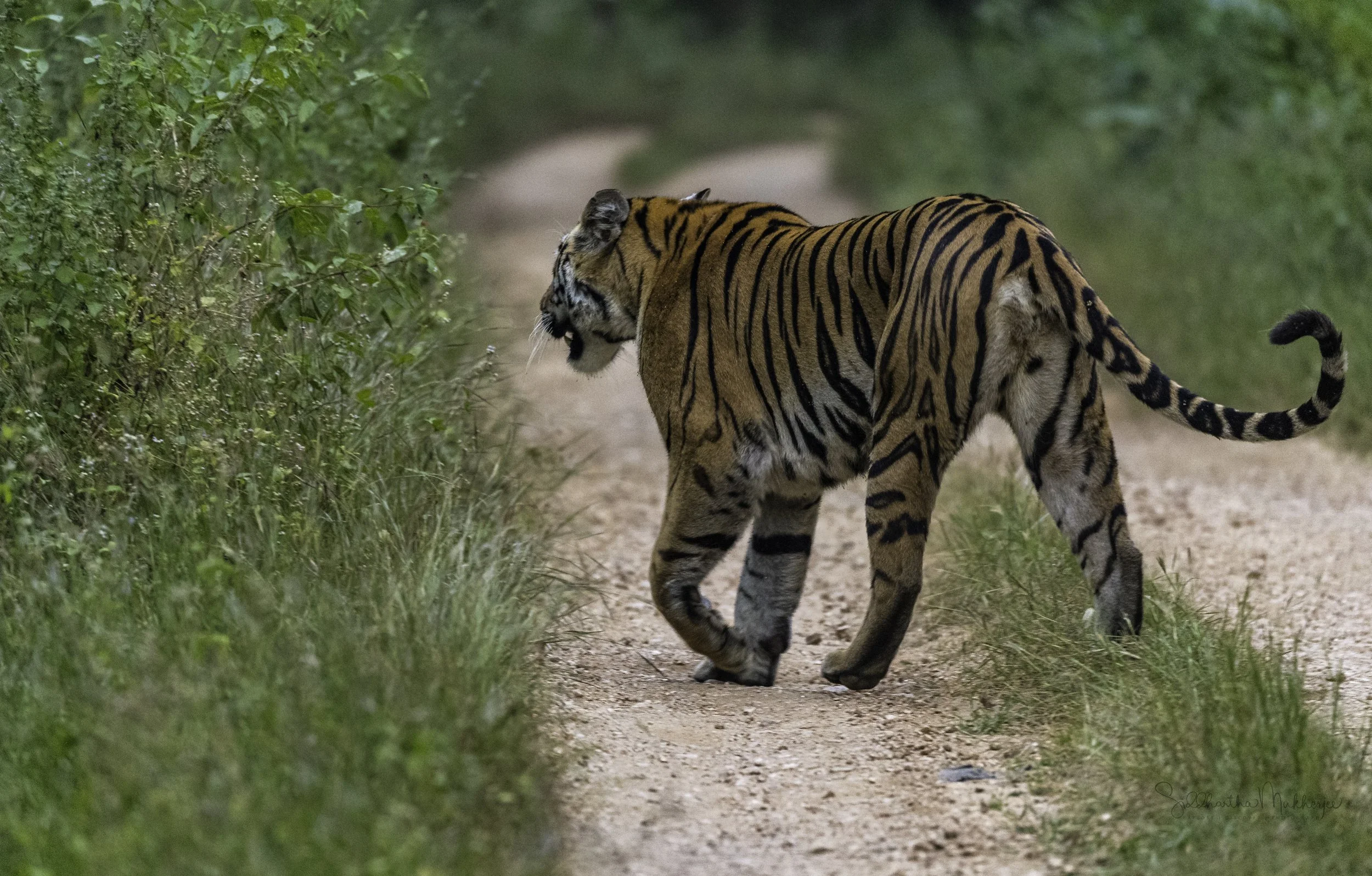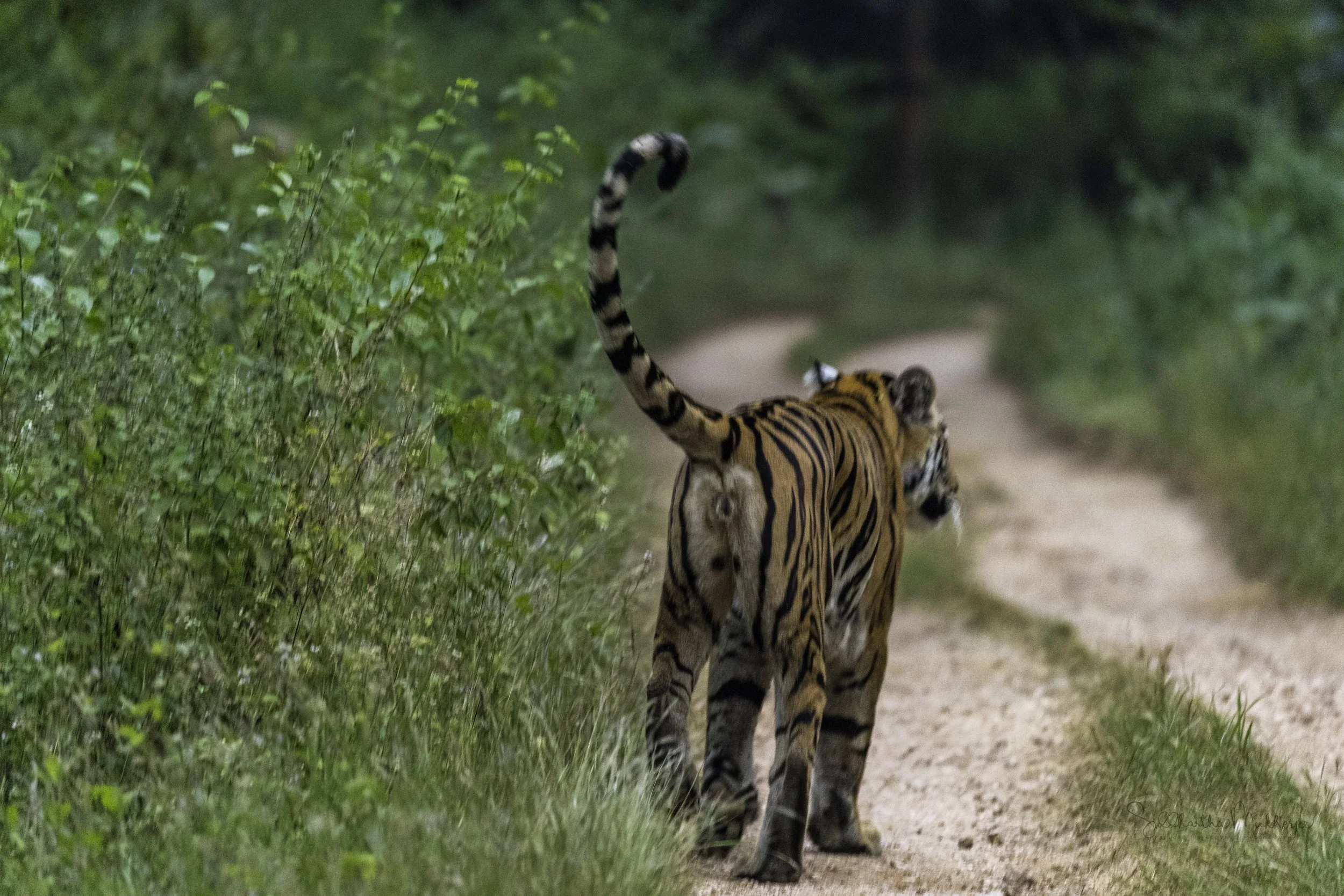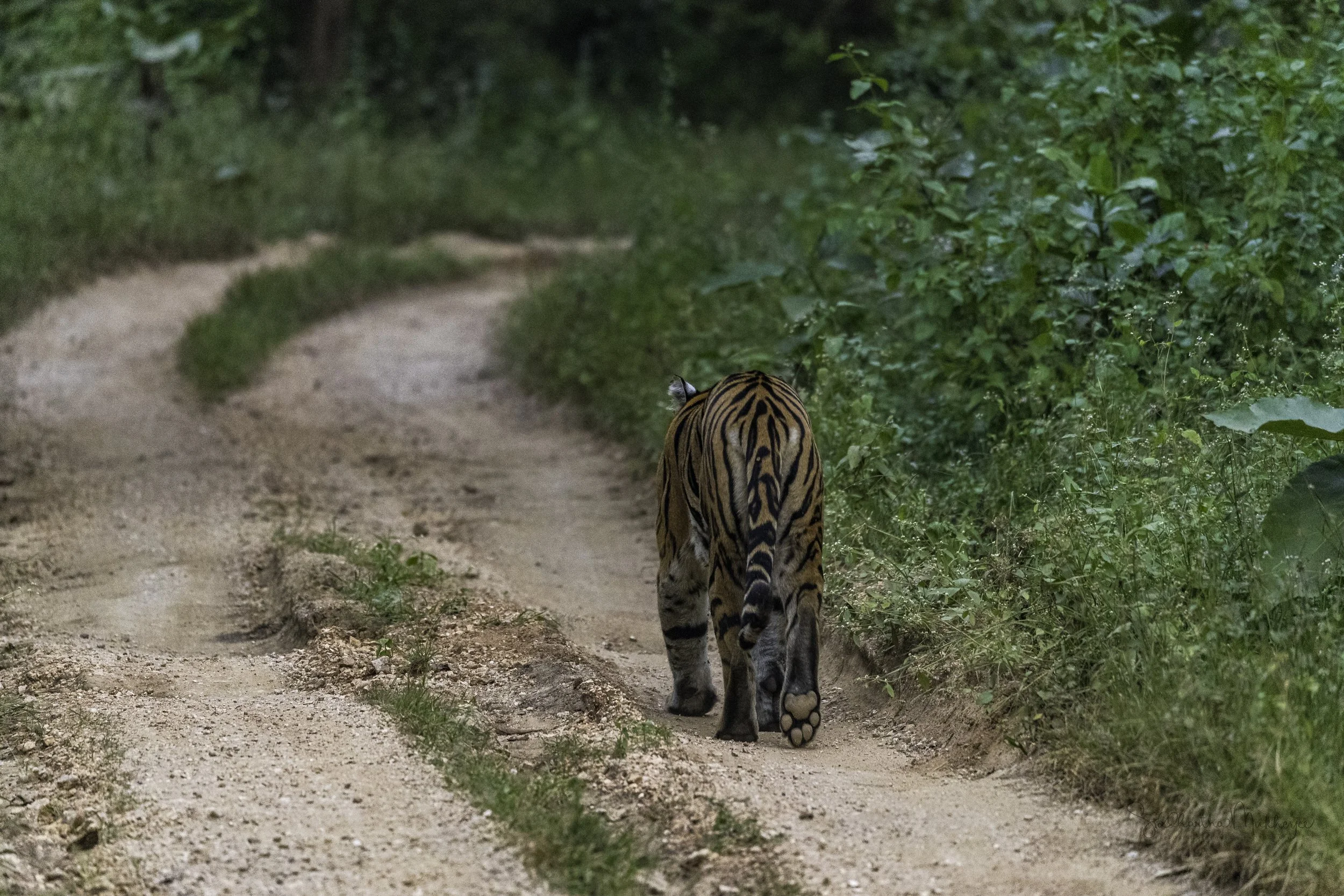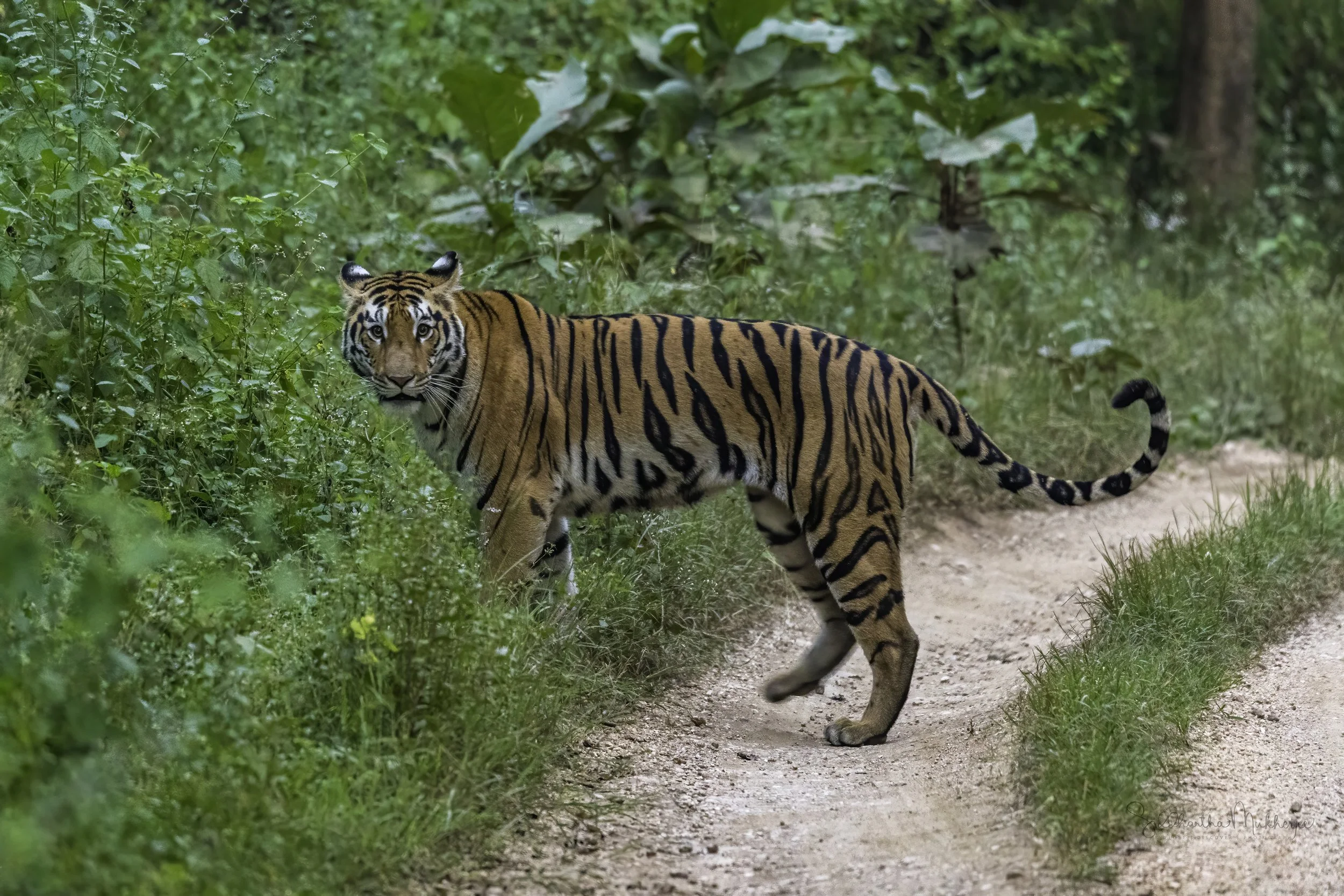The Vanchowki Tigress
Rukhad, Pench National Park
Panthera tigris tigris
ENDANGERED
The presence of a tiger changes the jungle around it, and those changes are easier to detect. Bird calls darken, deer call softly to each other. Herds do not run but drift into shapes that suggest some emerging group consciousness of an escape route. A kind of shiver seems to run through everything, a low hum that sounds — literally, in the whispered Hindi conversation of the guides — like sher, sher, sher! This zone of apprehension follows the tiger as it moves. Often, the best way to find a cat is to switch off your engine and listen. You might then hear, from a distance, the subtle changes in pitch and cadence that indicate a boundary of the zone. But even then, it is impossible to predict where, or if, the tiger will appear. I have written about this experience of meeting a tiger in the forests of Central & South India in earlier blogs and you can read about them via the button below.
Pench National Park
Pench National Park, nestled in the heart of India in the lower southern reaches of the Satpura hills, sprawls a massive 758 km² across the states of Madhya Pradesh & Maharashtra. In Madhya Pradesh it is located in the districts of Seoni and Chhindwara. Named after the pristine River Pench it was immortalised by Rudyard Kipling in his Jungle Book. Every year millions make their way here to spot Akela (the Indian Wolf), Baloo (the Sloth Bear), Bagheera (the Black Panther) and Shere Khan (the Royal Bengal Tiger). It was declared a sanctuary in 1965 and elevated to the status of national park in 1975 and enlisted as a tiger reserve in 1992.
Pench has a glorious history of natural wealth and unique cultural richness described in several classics ranging from the Ain-e-Akbari to the Jungle Book. Several natural history books like Strendale’s “Seonee - Camplife in the Satpuras” & Forsyth’s “Highlands of Central India” present a detailed panorama of these forests.
The forest, lush and green in the monsoon, also harbours a wide range of faunal species some of which figure prominently in the IUCN Red List. Our story, however, revolves around the beautiful and shy Vanchowki tigress who has made her home in the small hills and well-stocked teak mixed forest of Rukhad. Slated as the buffer zone and a part of the Pench-Kanha and Pench-Satpura Corridors, Rukhad used to be the hunting grounds of the British. With Granite & Gneiss as the main rock types, the area is filled with unique habitats like Snags, Nesting sites, Cliffs, Overhangs, Talus, Dens, Caves and natural salt licks - prime tiger habitat.
The park also was the location used by the BBC for the innovative wildlife series Tiger: Spy in the Jungle, a three-part documentary narrated by Sir David Attenborough which used concealed cameras, placed by elephants, in order to capture intimate tiger behaviour and also retrieved footage of various other fauna in the reserve. The programme aired for the first time in March 2008 and ended a month later.
Like all other forests in India tigers coexist with other predators such as leopards, Asiatic wild dogs, brown bears and wolves throughout most of their range. Usually there is little interaction between species especially since tigers are mostly nocturnal (active at night) and the other species are mainly diurnal (active during the day).
My grateful thanks to my companions - Angad, Rishi, Rahi & Golu - for bearing with me and my excesses. This would not have been possible without their help and incredible skills.
2021 population of tigers in India (Image Source: UPSC Notes)
‡‡‡‡‡
“The tiger will see you a hundred times before you see him once.”
The Bengal Tiger
The Bengal tiger ranks among the biggest wild cats alive today and is considered to belong to the world’s charismatic megafauna. It comes from the specific population of the Panthera tigris tigris subspecies that is native to the Indian subcontinent. It has been and still is threatened by poaching, loss and fragmentation of habitat, and was estimated at comprising fewer than 2,500 wild individuals in 2011. Today that number has grown considerably thanks to many awareness programs and initiatives by the central and state governments and the forest department.
The tiger is estimated to be present in the Indian subcontinent since the late Pleistocene, for about 12,000 to 16,500 years.
Hair & Colouration
Probably the most easily recognized of all wild cats, tigers are the only large cats to have distinctive striping located on both the hair and the skin. Their fur ranges from orange to brownish yellow with a white chest and the belly is covered with broken vertical black/dark brown stripes. Males of all the sub-species exhibit longer fur in the form of ‘ruff’ around the back of the head. This is especially pronounced in the Sumatran males.
Many tigers possess stripes on their face, sides, legs and stomach. The striping is varied in width, length, whether they are single or double-looped, coloration from a light brown to dark black and are not symmetrical from one side of the tiger to the other. The stripe pattern on top of the animal’s head resembles the Chinese character of “wang” which means “king.” Many tigers possess light yellow-orange to deep reddish-orange background coloration.
Tigers have distinctive white circular spots on the backside of their ears. There are two ideas as to the function of these eye-spots. One of which is that they function as “false eyes”; making the tiger seem bigger and watchful to a potential predator attacking from the rear. The other idea is that they play a role in aggressive communication because when threatened tigers may twist their ears around so that the backs face forward. This prominently displays the distinctive white markings. The function of the white markings is probably a combination of both ideas.
Climate Preferences
Tigers have much less rigid climate needs, but they have special attraction for water that is why they are never away from the water source. When both lions and tigers were widespread in Asia, perhaps, the tigers’ liking for water may have kept them out of more arid areas favoured by lions. They are strong swimmers with a love for bathing in pools and lakes in summers in hotter climes, tigers are adapted to most types of forests and grasslands broken by woods, swamp margins beyond woodland areas and they are seldom found in wide-open country. Basically, they are nocturnal hunters; however, in protected areas – away from human intervention – they are often active during the day. Their striped coat blends well into sun-dappled vegetation.
They usually frequent water holes at dusk and dawn – the time when most animals come there to quench their thirst. Although the habitat dictates the type of animal that the tiger would hunt, it has special liking for larger prey species, such as sambhar, gaur, chital, wild boar and monkeys. Occasionally they go even for fish and various other small mammals if food is scarce.
Territory and Communication
The size of tiger territory varies greatly by prey density, locality and season. In areas where prey is in abundance the territories tend to be smaller in size. For male tigers in tiger reserves like Tadoba & Ranthambhore the prey concentrations are high and male tigers have territories that range in size from 5 to 150 sq km. Contrastingly, in Siberia the prey concentrations are much lower and male tiger territories range in size from 800 to 1200 sq km. Seasonality in terms of prey migrations, food availability and weather also affect prey populations and therefore the size of tiger territories.
A male tigers territory usually encompasses that of more than one female and is aggressively protected against intrusion from other males. The larger area contains more than enough food, water and shelter and also accommodates more females. Therefore, females are the most coveted resource for males. Tigresses’ territories are smaller than that of the males but focus on vital resources required for rearing young. Tigresses usually occupy territories adjacent to or take over parts of their mother’s territory.
Tigers assert and maintain their control over their territories by continuously patrolling them, but this is not the only method to guard such a vast area. They have devised very powerful and silent communication systems to convey their presence, movement and territorial claim. Spray-marking is one such method in which tiger, male or female, while walking turns its hindquarters towards a tree, bush, or a big stone or pole and with vertically raised tail will shoot out spray of fluid. This strong musky smelling fluid is a mixture of urine and a secretion from the anal glands.
The Vanchowki Tigress
I could not find our much about the back story of this tigress. Our guide and naturalist just knew that she was first spotted near the old Van Chowki (forest checkpost) and since then has been seen frequenting that area earning her the moniker. She is a young tigress in her prime and I suppose she has come in search of a mate. When we first spotted the Vanchowki tigress she was making her way west through the dense brush towards some fields bordering the village of Suktara. She was some way off from us and the brush didn’t provide any opportunities for a clear photograph or video.
Suktara
Suktara village is located in the Keolari tehsil of Seoni district in Madhya Pradesh, India. The town of Keolari, named after a kind of paddy "keolar" which was profusely produced in this region, is the confluence of the Wainganga and Sagar rivers. Suktara is situated 13km away from the sub-district headquarter Keolari and about 65km away from district headquarter Seoni. As per 2009 stats, Suktara village is also a gram panchayat spread over almost 560 hectares and consisting of around 229 households. From an earlier census in 2011 the about 917 people inhabit the village. Suktara borders one of the important buffer zones of Pench Tiger Reserve - Rukhad. Buffer zones are primarily forest areas which form the periphery of the core zones. Just like the core zones, there are restrictions and regulations which are placed upon the usage of resources from these zones and to enhance its conservation values.
These zones are crucial to the conservation of tiger and other fauna as they serve as additional forests to absorb the growing population of tigers providing them a great habitat for sustenance. With a high prey density, it supports dispersing tigers venturing out from the Pench Tiger Reserve. Rukhad is of crucial importance as not only does it act as a buffer zone but also serves as a connecting forest between two crucial tiger reserves – Pench & Kanha. Also known as the ‘two tiger corridor’, the connecting forest allows tigers and other wildlife to move freely from one reserve to another. This is good for the overall conservation as it ensures gene flow variation.
The forest, lush and green in the monsoon, also harbours a wide range of faunal species some of which figure prominently in the IUCN Red List. Rukhad is primarily a rocky and hilly area with a mixture of moist and dry deciduous forests. Interspersed with flowing streams and other water holes, Rukhad is lined with bamboos and other trees commonly found across the region and is also home to Kurai Ghat, the highest point of Rukhad where the Kuraigarh Male has made his home. Read about the magnificent and big Kuraigarh Male tiger here.
The 111 square kilometres area of Rukhad used to be the hunting grounds of the British. With Granite & Gneiss as the main rock types, the area is filled with unique habitats like snags, nesting sites, cliffs, overhangs, talus, dens, caves and natural salt licks - prime tiger habitat. In the monsoon, the already winsome place becomes more attractive with thick green cover and a wide variety of flora and fauna. The old 'daak bunglows' add to the charm along with the mixed vegetation which can be seen at this time of the season.
For more videos: Videos
“One can hear a tiger roar from over a mile away!”
Listen to the jungle announcing the approach of a tiger and finally the tiger himself making it clear who the king is.
Visual, Scent & Touch
Tigers use their tails, which can be about a meter long, to communicate with one another. A tiger is relaxed if their tail is loosely hanging. Aggression is displayed by rapidly moving the tail from side to side or by holding it low with occasional intense twitches. Tigers may enhance their olfactory communication by using visual markings such as scrapes on the ground and trees.
Adult males and females both communicate to one another by marking their territories. An adult tiger will usually define the boundary of its territory by spraying urine because of the strong odour associated with it can last up to two months but they may also use faeces for marking. Smell is also a very accurate indicator to other tigers of how recently a tiger has passed, and whether or not the territory is occupied.
All cats, including tigers, have a distinct scent associated with them due to their individualised scent glands. This scent helps cubs track their mother’s path and serves to identify particular individuals. Cats have scent glands between their toes, tail, anus, head, chin, lips, cheeks, and facial whiskers. The animal’s intention is to leave its own distinct scent to communicate with other animals of its species and mark its territory. The scientific community is currently trying to train dogs to detect some individualised tiger scents to assist with the estimation of wild tiger populations.
Like all cats tigers too have a well-developed sense of touch, which they use for many purposes including navigation in darkness, detect danger and attack prey. They have five different types of vibrissae, commonly known whiskers, which detect sensory information and are differentiated by their location on the body. Whiskers differ from guard hairs in the sense that they are thicker, more deeply rooted in the skin and surrounded by a small capsule of blood. The root of whisker displaces the blood when it comes in contact with something, thereby amplifying the movement. Sensory nerves detect this movement and send signals to the brain for interpretation. Whiskers are so acutely sensitive that if they move five nanometers (a distance 2000 times less than the width of a human hair) its sensory nerve sends a signal to the brain.
As we followed the tigress through the dense brush, she went out of sight for a few minutes. We decided to stick to the same line she was following and went ahead for a couple of minutes. The next thing we know, she was standing very quietly just a few meters to our right waiting to cross the track. By the time we spotted her we had gone ahead a meter or two and the first photo in the gallery below is looking back at her as she was looking at the safari vehicles behind us. Unfortunately, these vehicles following us were a little too close for her comfort and she decided not to cross the road and continued to follow her earlier line down to the fields bordering Suktara. The subsequent photos are from that unexpected and brief encounter with the Vanchowki tigress.
Finally, at the bottom of the hillock, where the track separates the forest from the fields bordering Suktara, she decided she had had enough of squeezing through the dense foliage and came back again towards us on the track. By this time the word of her walking had spread and there were far more vehicles than she liked. She once again made her way to the track and stood by a tree looking at all the vehicles lined up on the track. The last photo from the gallery above is where she looked left and right at the vehicles and finally back to us looking directly into my camera.
She stood by this tree looking up and down the track at the vehicles which, I think, were preventing her from crossing over to the fields on my left. At the time, I think, she probably only wanted to get out of the dense foliage she was in and walk on the track but the sheer number of vehicles was a deterrent. At this time the vehicles in front of us decided to move ahead to get a head on angle and we decided to stay put as the track took a diversion. One path went down beside the fields bordering the village of Suktara and the other went back up into the forest and took a pretty hard turn after a few hundred meters. So not knowing which way the tigress would go we decided to stay where we were and follow her as she went on her way.
After a few minutes there was a big enough gap in front of us for her to feel comfortable and out she came onto the track which is where I took my video and some photos as we started to follow her as she took the track back into the jungle. It is a magnificent sight watching a royal bengal tigress in her prime walk confidently down a track marking her territory.
After walking down the track, marking her territory, she finally for a brief moment, turned to look back at us giving me this shot. A moment I will cherish forever.
She then turned completely around rubbing through the foliage to leave her scent and continued for a few meters more along the track before finally deciding to step off into the foliage again. This time she was headed towards the track bordering the fields of Suktara and some of the vehicles reversed and took off down that track to get her again as she came out on that side. I do not know if that happened because knowing how disturbed she had been, and how she had patiently navigated around the numerous vehicles, we decided to head a different way thankful for the time we had with her.
This then was my experience with the beautiful and she Vanchowki tigress of Rukhad.
Related Posts

